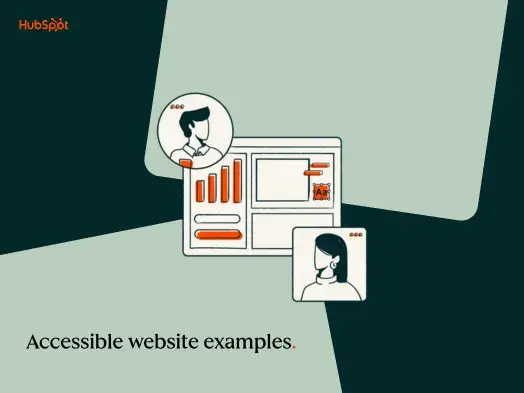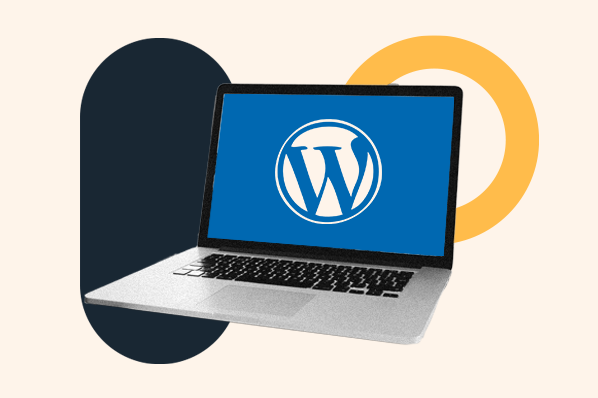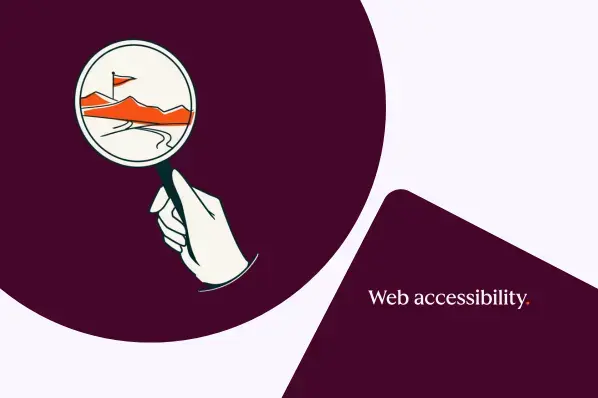In 2023, 4,605 web accessibility lawsuits were filed in the United States, while companies in the EU have until June 2025 to fully implement web accessibility standards under the European Accessibility Act.
With that in mind, I tested out a few AI accessibility tools to see what capabilities are currently available and how they can help to keep websites compliant.
Table of Contents
How to Use AI for Accessibility
There are a few ways AI can help speed up and improve web accessibility. Here’s what I found.
Accessibility Audit Automation
It’s estimated that approximately 1.3 billion people around the world experience significant disability. Around 75% of Americans with disabilities access the internet daily. Websites that ignore the needs of people with disabilities risk losing a large amount of traffic and revenue every year.
Knowing whether your website is fully accessible to this population requires a deep and thorough audit of all your web pages and website functionality.
When done manually, accessibility auditing can take a long time. Even free tools like Google Lighthouse, which provide a score and improvement recommendations for web accessibility can only do so one page at a time.
Not only can AI-powered tools do this at scale for entire websites, they can quickly compile issues and recommended remediations based on Web Content Accessibility Guidelines (WCAG). Some AI tools can even auto-correct key issues in real-time for users on your site.
Alt Text Generation
Alt Text must be written in a very specific way to be useful to people with disabilities. Producing it for all images on a site can be really time consuming and is something I have had to spend a lot of time on in the past.
But it’s important. People with screenreaders rely on alt text to navigate and understand your site’s content successfully. However, approximately 26% of home pages contain images without alt text.
With AI, you can leverage tools that can scan images and automatically generate useful alternative text to make the content accessible for people using screen readers. It saves a lot of time and ensures your alt text is written according to accessibility best practices.
Readability Improvements
The World Health Organization (WHO) states that approximately 2.2 billion people worldwide have a vision impairment, ranging from mild impairments to blindness. From low vision requirements to cognitive disabilities, there are lots of ways that on-page text can hamper the accessibility of a site.
AI tools can help with this in several ways by:
- Simplifying language.
- Breaking up long sentences and paragraphs.
- Suggesting more readable versions of copy.
- Highlighting key information like headings and buttons.
- Adjusting font sizing and line spacing.
- Increasing or decreasing contrast.
- Suggesting more muted or fluorescent color palettes.
- Hiding images, graphics, or animations.
These types of content adjustments can assist with many different types of accessibility needs. Plus, AI tools usually allow the user to select which adjustments they need and update the content accordingly.
Captions and Transcripts
Captions and transcripts are extremely valuable for video content and absolutely necessary for some people to be able to access the content at all. It’s also a common preference — 50% of people have captions turned on always when they watch TV or online video content, with the percentage even higher among Gen Z users at 70%.
But captions can be time-consuming to generate and edit. AI accessibility tools can help speed up and automate this process, even automatically translating the captions for users as needed.
Dynamic Content
It’s clear that there is often no “one size fits all” approach to accessibility. People have a hugely diverse range of needs when it comes to browsing the internet comfortably. Taking some accessibility features into account (e.g., grayscaling your content) can then also hamper the accessibility of the site for others.
Where AI is massively useful in this area is its ability to dynamically update your website content according to user-selected accessibility preferences. There are some great examples of this in the tools I tested.
Typically, a website widget will provide multiple accessibility options and customizations for users. Once the user selects their preferences, the site content updates accordingly. This includes colors, cursor size, screen reading, font adjustments, and lots more.
Accessibility Adaptations in Real Time
Aside from user preferences, AI tools can automatically help take care of accessibility issues in real time.
A good example is auto-generating alt text as a user browses your site with a screen reader, even if you didn’t originally set any alt text.
This extra layer of functionality makes your website as compliant as possible, even while you continue rolling out other improvements and updates.
I Tried and Tested 6 AI Accessibility Tools
Having only dipped a toe into what AI can do for accessibility, I decided to select some of the most popular AI-powered accessibility tools and try them for myself.
1. ChatGPT
ChatGPT is OpenAI’s primary offering, a natural language processing (NPL) tools with a huge range of use cases. One use case is accessibility testing, and it’s easy to ask the tool to assess a variety of accessibility features.
For example, you could use it to generate alt text, check on color contrast levels, ask it to review HTML for elements like forms to ensure accessible labels are included and accurate, and lots more.
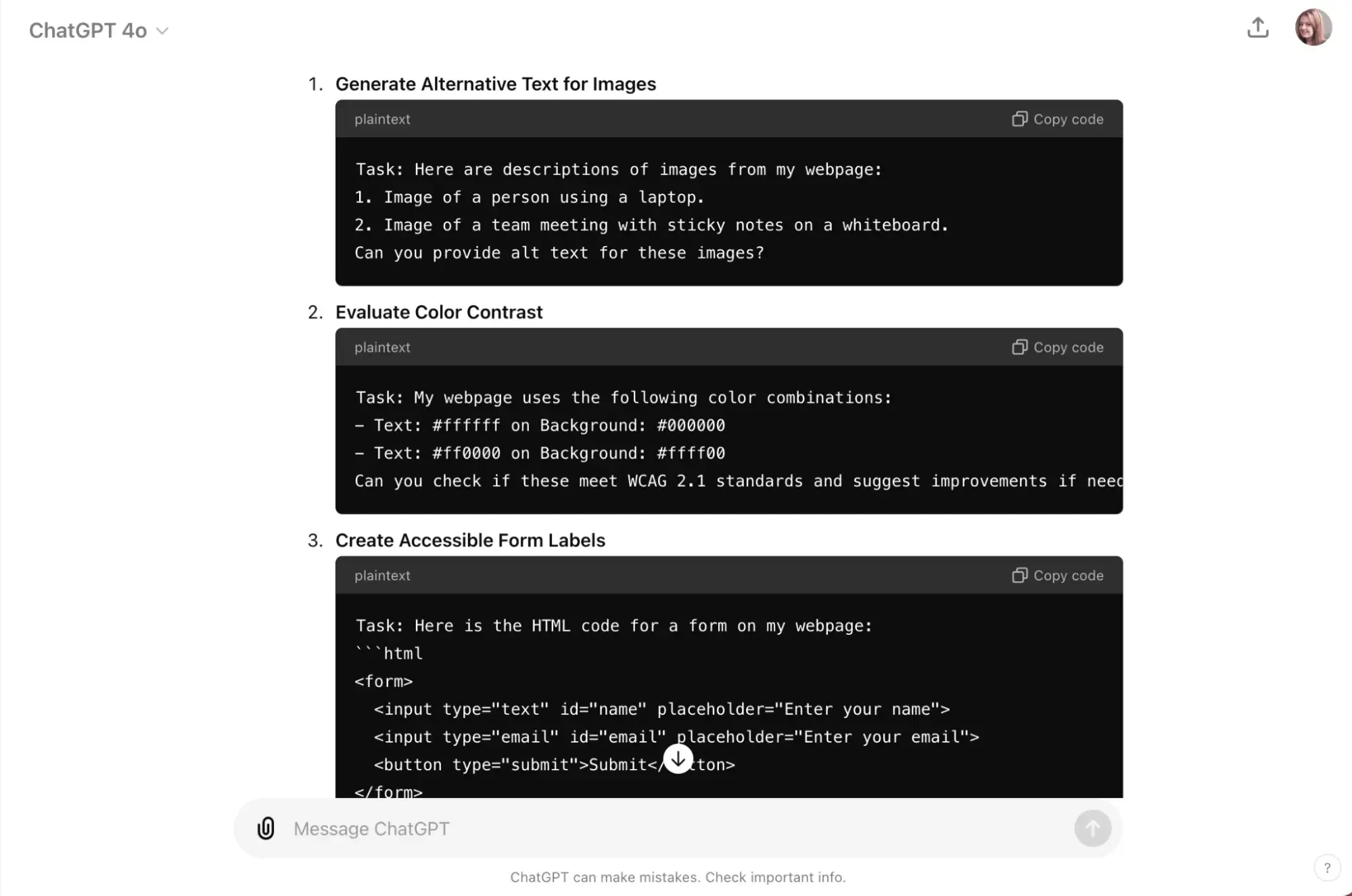
I used ChatGPT to provide some alt text for images, check the contrast between different HEX codes I’m using for background and text colors and create accessible labels for the HTML code of a website form.
Although the AI-driven tool is extremely impressive, it’s not specifically built for web accessibility. So, if you have a large volume of web material to test, it would still be quite a time-consuming task. But for one-off projects here and there, it’s ideal.
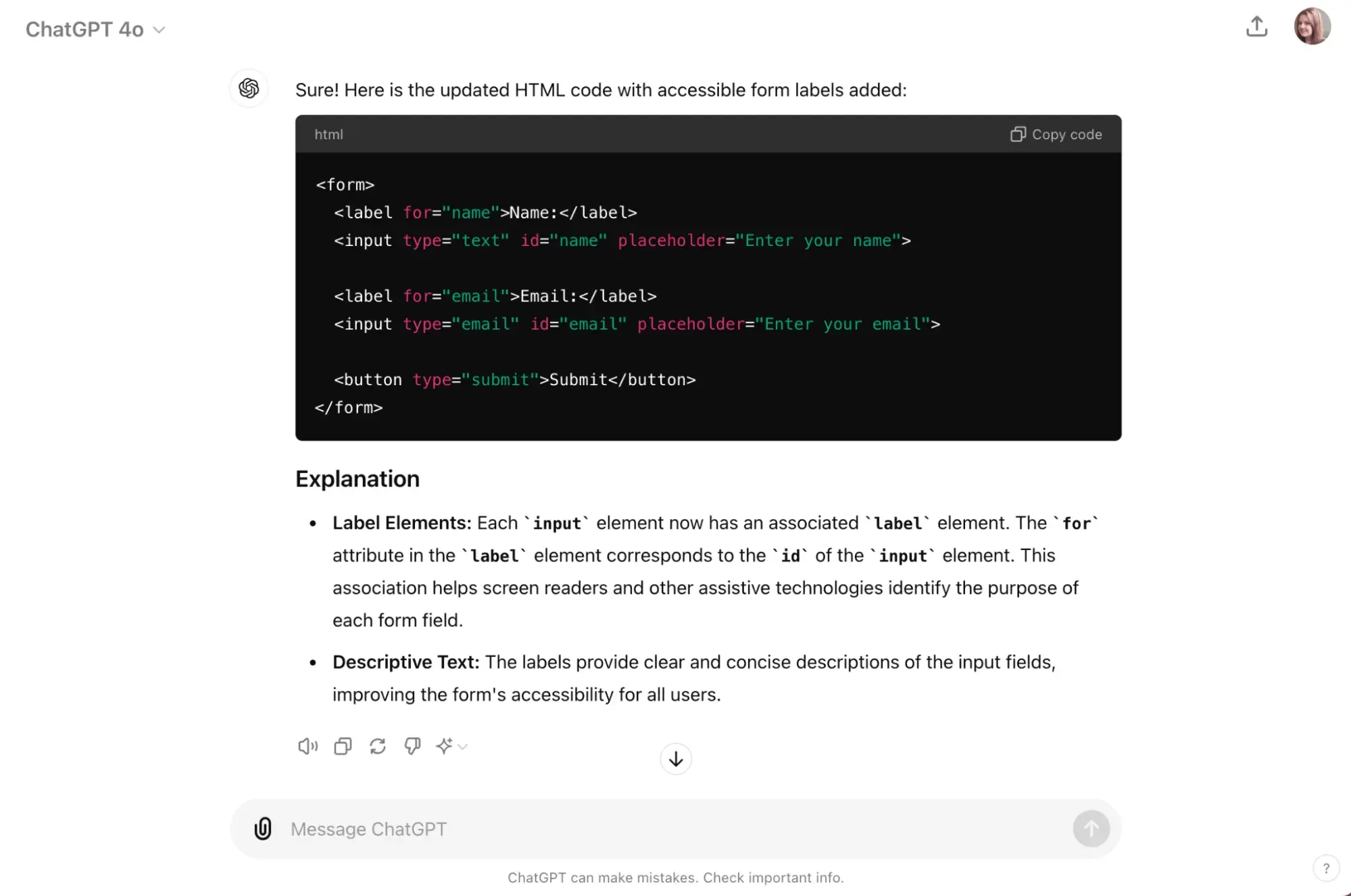
Pricing: The free version can still be used for some accessibility testing, but has limited features. Paid accounts start from $20 per month.
What I Like: ChatGPT is so flexible that you can use it for almost every accessibility use case out there. Plus, you can almost bargain with it. With other tools, if you don’t like a feature or its missing functionality, there’s not much you can do about it. But ChatGPT’s flexibility and interface means you can follow up to clarify your request and needs.
2. Siteimprove
Siteimprove provides lots of different solutions and products, predominantly geared towards content production. Among tools like Search Engine Optimization (SEO) checkers, content governance tools, and marketing analytics is Siteimprove’s accessibility checking tool.
The accessibility tool checks your website regularly and auto-generates a report with recommended actions, using machine learning models to check your web pages and PDF documents against WCAG 2.2 standards.
I used the free version of the tool that provides one-off checks for individual pages to test a random page on a popular news website.
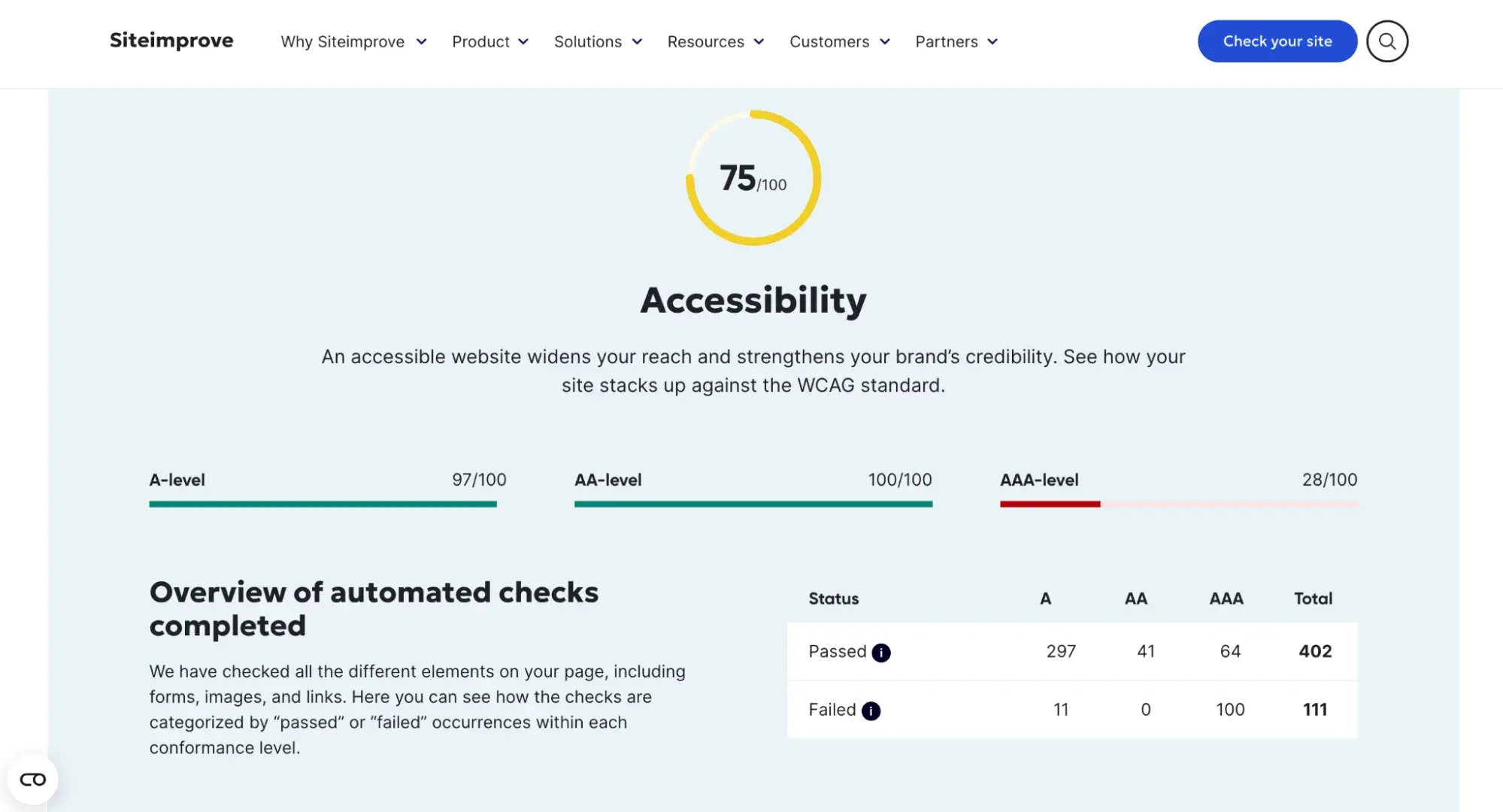
While the free tool gives a good overview of the number of checks, how many you failed, and in which category of the WCAG standard, you can’t access any further detail than this. However, if the number of checks is anything to go by, it seems a detailed report and recommended actions would be very in-depth and useful.
Pricing: Siteimprove does not offer a free trial. Pricing is custom and only provided on request.
What I Like: From using the free version of the tool and checking out customer reviews online, it seems Siteimprove is a very comprehensive testing tool for accessibility. Users can scan their entire site, benchmark their accessibility performance against industry standards, and leverage actionable recommendations for improvement.
In comparison to free accessibility checks for individual URLs like Google Lighthouse, the ability to get site-wide recommendations is a huge time saver.
3. EqualWeb
EqualWeb is a full web accessibility solution. You can use it to install an AI-powered widget on your website that remediates accessibility issues for users in real time. The software also provides a web accessibility crawler, an accessibility checker for WCAG 2.2 compliance, and an ongoing monitoring solution.
You’ll need an active website and access to its settings to install the HTML code used for the accessibility widget. But I did go through much of the setup process and it was very straightforward — you can even customize the design.
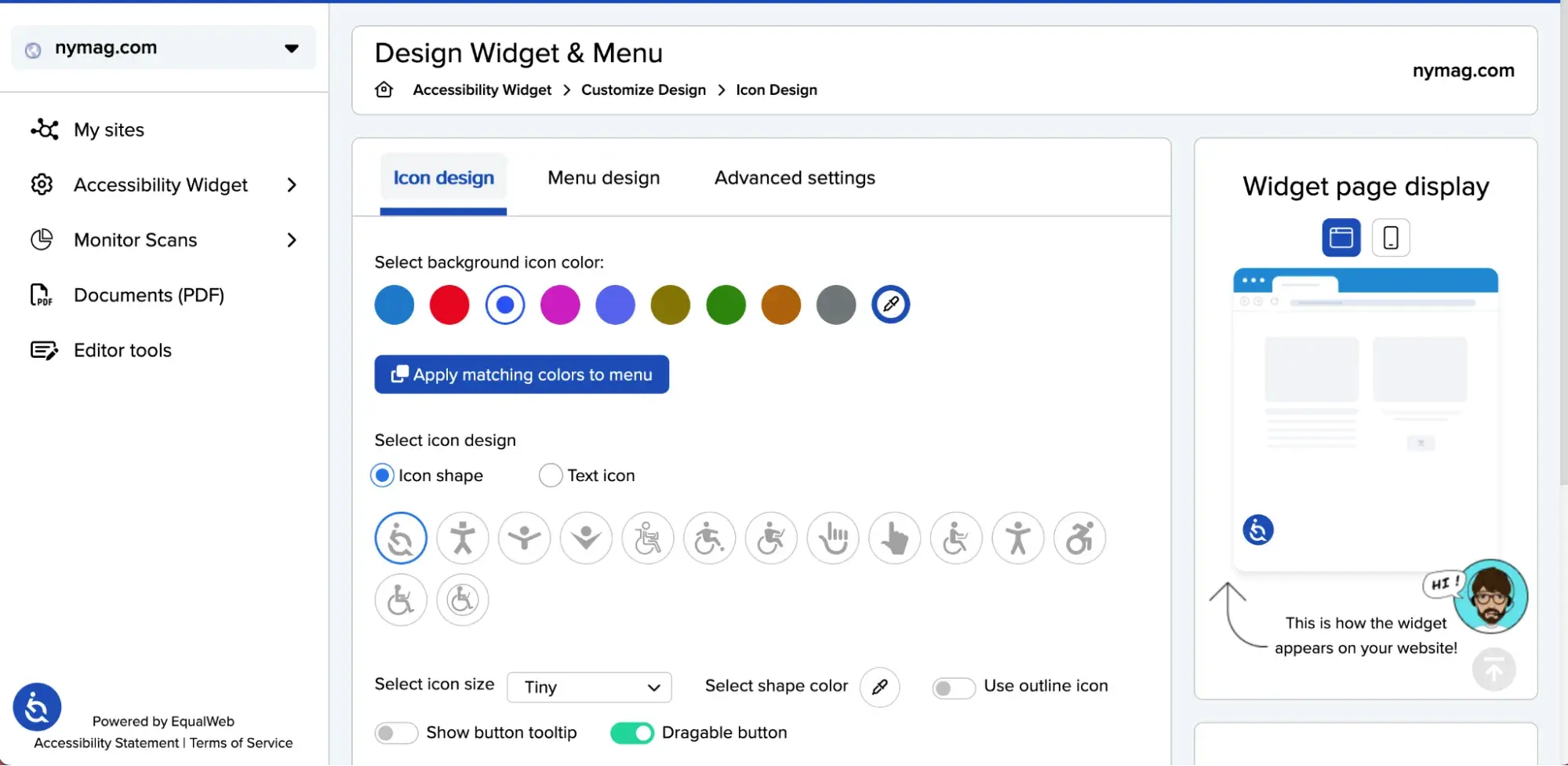
Next, I tried the Scan tool and was really impressed by the depth of both the checks and recommended actions provided. You can check by error, or by individual pages, filter errors by A or AA level under WCAG guidelines, and track issue resolution.
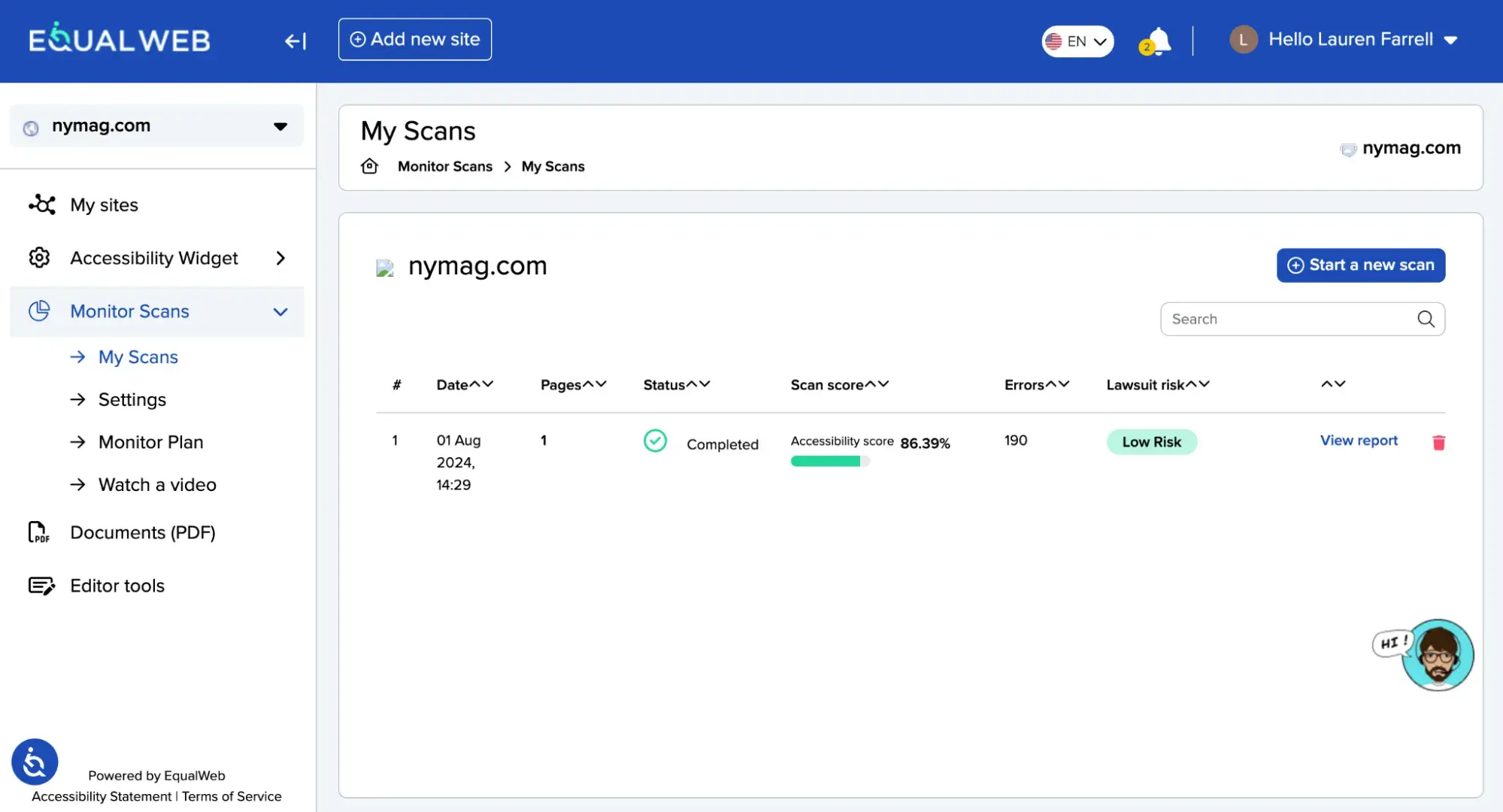
With the browser extension tool, you can generate similar reports for any website right from your browser.
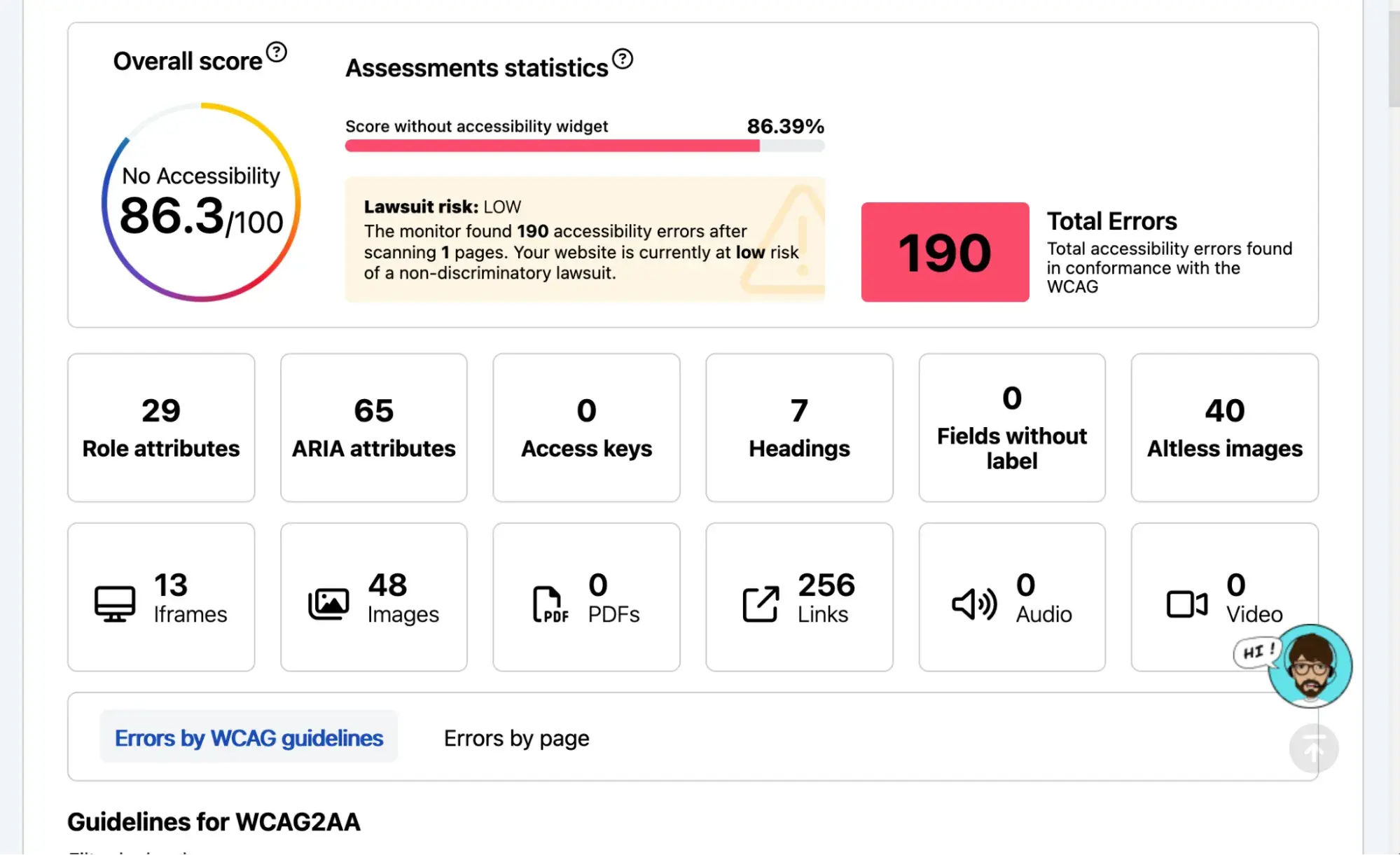
Pricing: Starting at $39 per month for small websites (up to 100 pages), EqualWeb has several pricing tiers up to $169 per month for “huge” websites (up to 100,000 pages). Expert guidance from in-house accessibility experts can be purchased as an add-on for a custom price, and all features apart from that are available during the free trial for seven days.
What I Like: I can see EqualWeb being useful for almost any industry and size of company, especially with their pricing tiers. It seems like a highly cost-effective solution for the value it brings, and the ability to resolve accessibility issues in real time with AI is truly impressive. The interface was very straightforward to use and setup takes only a couple of minutes for both the widget and the scan reports.
4. accessiBe
accessiBe provides a similar solution to EqualWeb. Its main feature is an AI-driven widget that you can install on your website to help users access and navigate all features with ease.
A list of client websites on the homepage allowed me to check out the accessibility widget in real-time. The widget allowed me to customize the website according to my needs. Once that was done, the website updated accordingly (this is the part that’s done by AI).
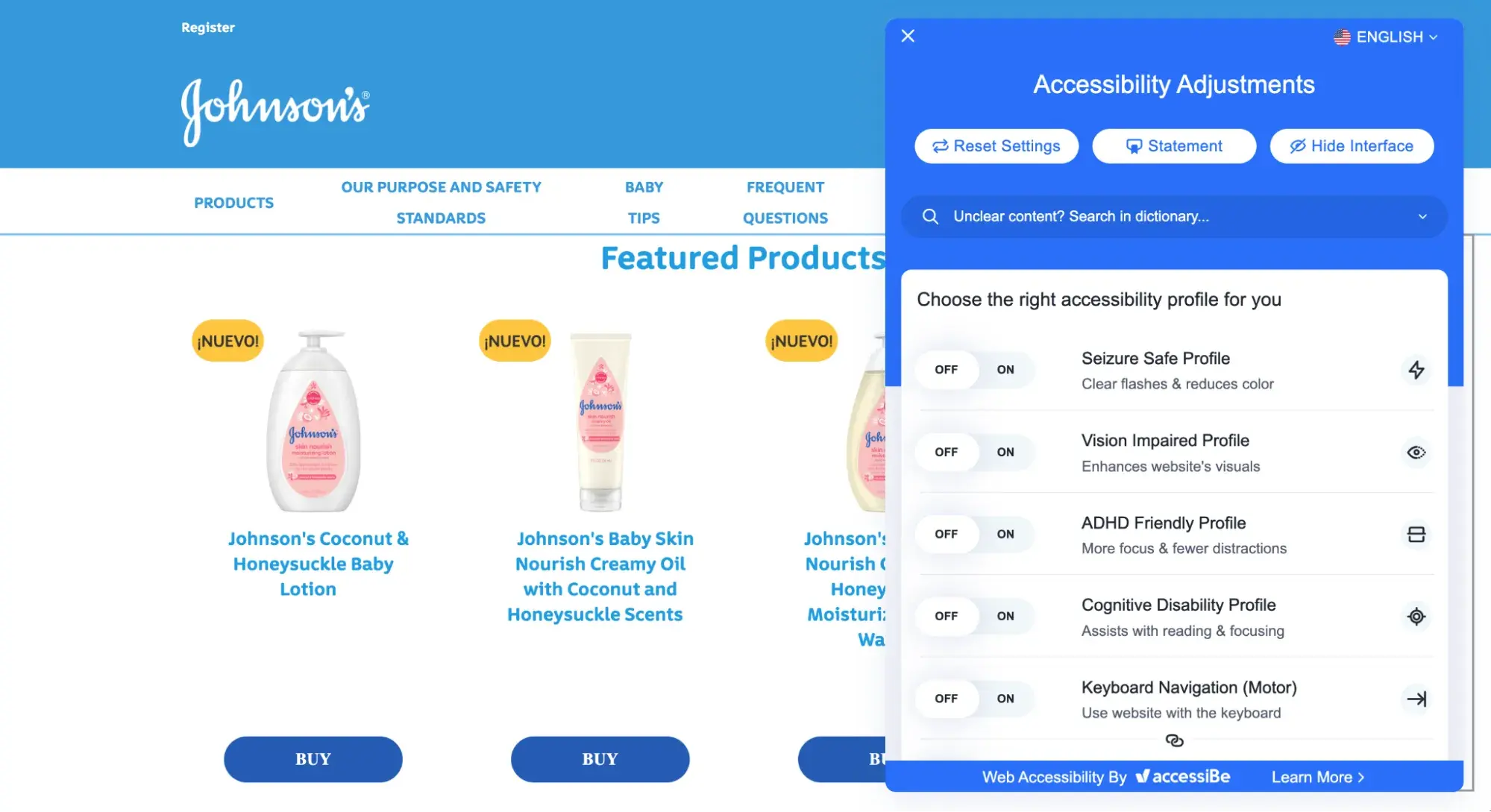
The range of customization available is impressive. Apart from some of the features you would expect, like keyword navigation and enabling screen reader access, some settings include seizure-safe viewing, automatic visual impairment enhancements, an ADHD-friendly site with reduced distractions, and a cognitive disability profile to help with reading. Scrolling further down, you can set colors, font sizing, highlight specific elements like links or headers, adjust the contrast, select custom cursors, and more.
After that, I just closed the widget and went on with browsing the site.
I went back to the product itself to start a free trial, and could not find an option to customize the design of the widget. But it did seem like a very straightforward installation process and you can even auto-generate an accessibility statement for your site.
Next, I tried the audit scan. It provided a lot of checks and categorized them by elements (e.g., forms, titles, menus, etc.). The breakdown of each category shows you errors and the HTML where accessibility failures occur. It even highlights which people would be affected by this error while using your site.
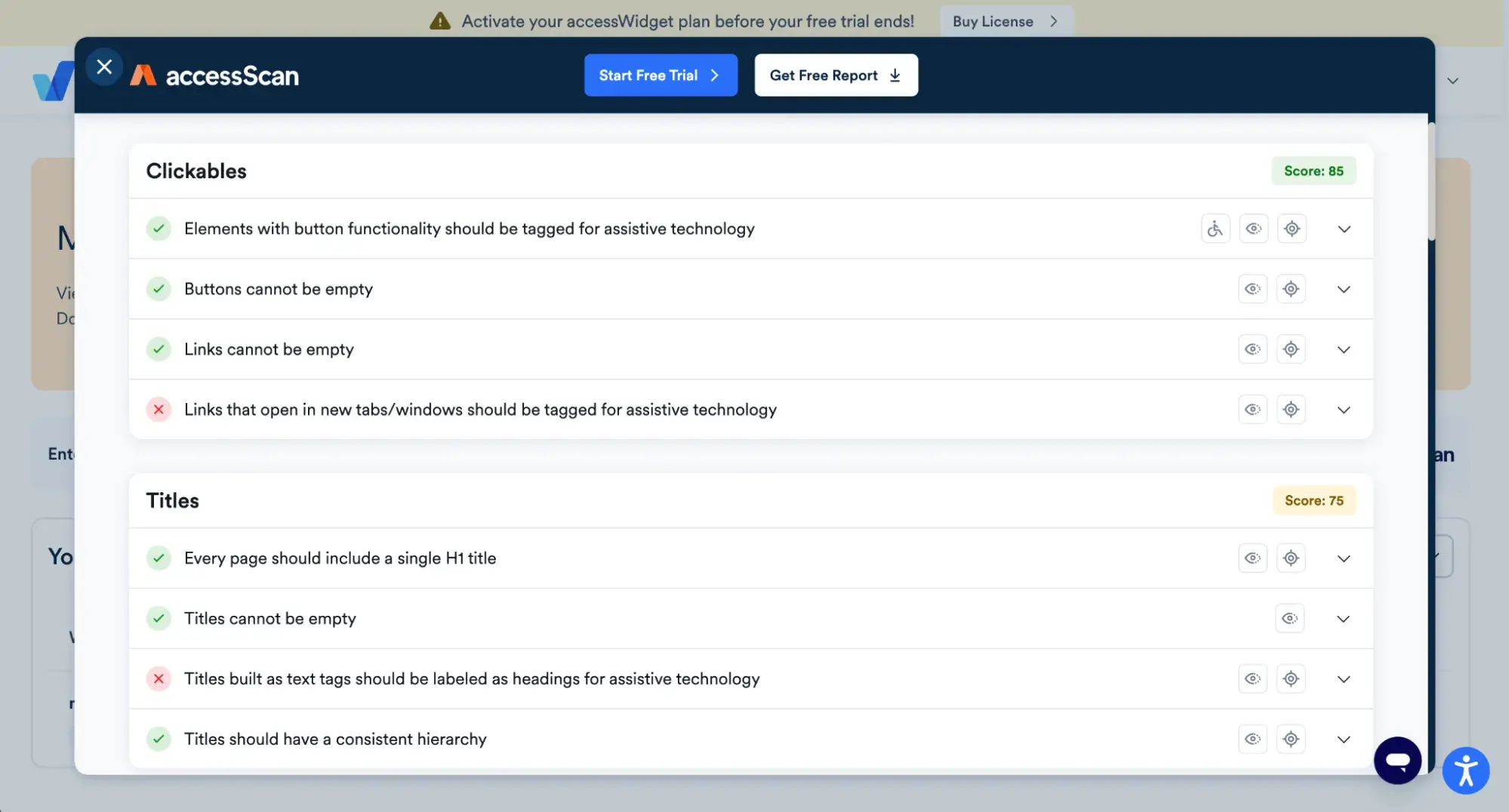
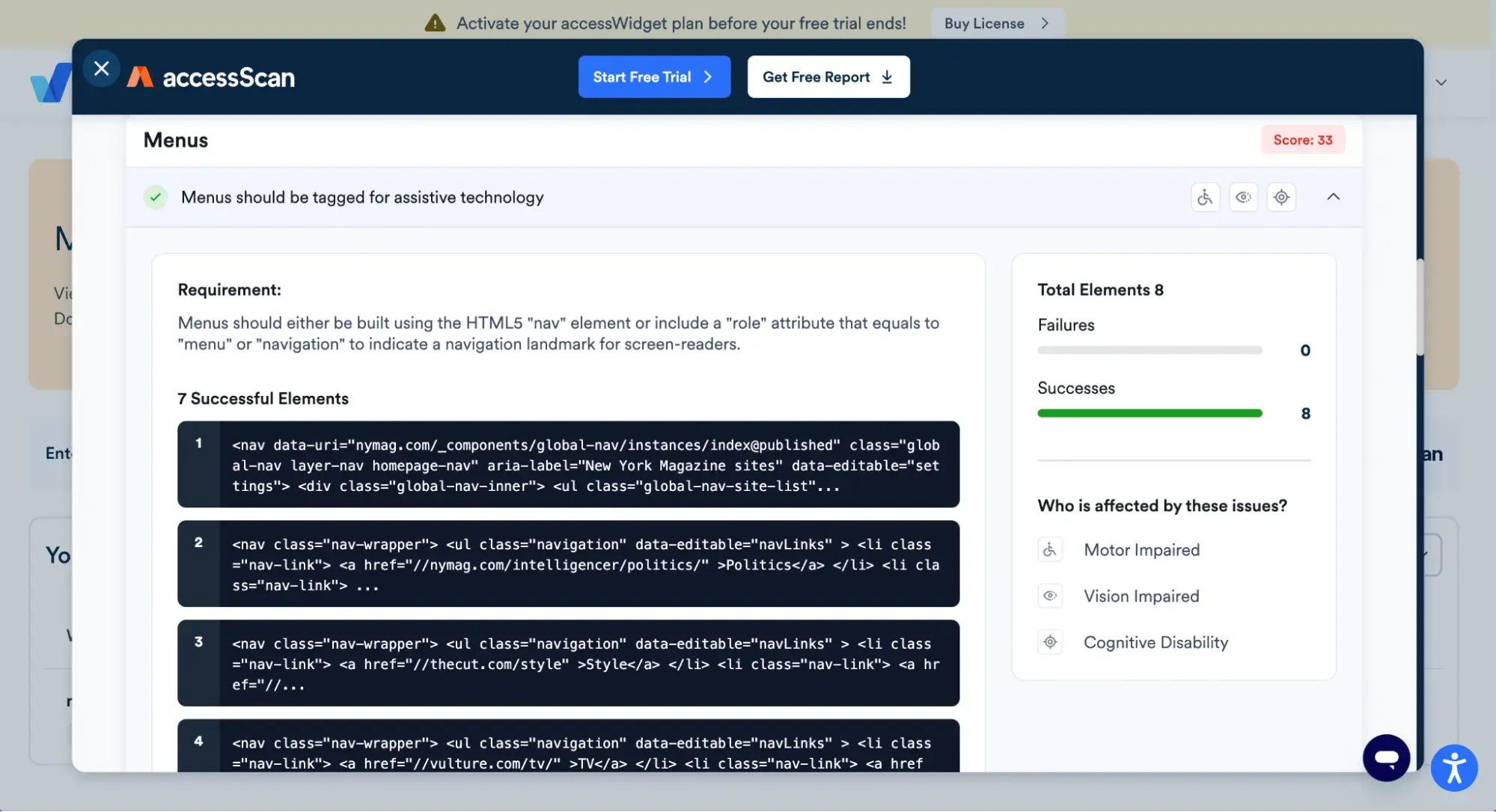
Pricing: Plans start at $49 per month for websites under 1,000 pages, $149 for websites under 10,000 pages, $349 for websites under 100,000 pages, and custom enterprise pricing for unlimited pages. Annual billing provides a 20% discount and a free trial is available for seven days.
What I Like: The functionality of the widget itself as an end user is really impressive. On the back end of the tool, the interface could be a little cleaner, but is overall very straightforward to use. I also liked that you can integrate with Google Analytics and get detailed PDF reports for individual checks and remediation steps.
5. UserWay
UserWay provides an AI website widget, accessibility auditing and monitoring, and free tools like a contrast checker and a dyslexia-friendly font generator. The widget takes user preferences into account, but the AI also takes care of lots of things automatically in the background — like automating alt text for images that do not have any.
There is also a totally free version of the widget with user-selected accessibility features, but you won't get the AI functionality or more advanced tools like screen reader and smart contrast.
To access a free trial of UserWay, you’ll need to enter your credit card details. Also, adding a high-traffic site during your registration process will require you to book a sales meeting rather than accessing the free trial, too.
However, I was able to check out the widget on one of their customer websites.
The widget makes it easy to select different profiles with pre-set accessibility settings such as motor-impaired, low vision, dyslexia, and more.
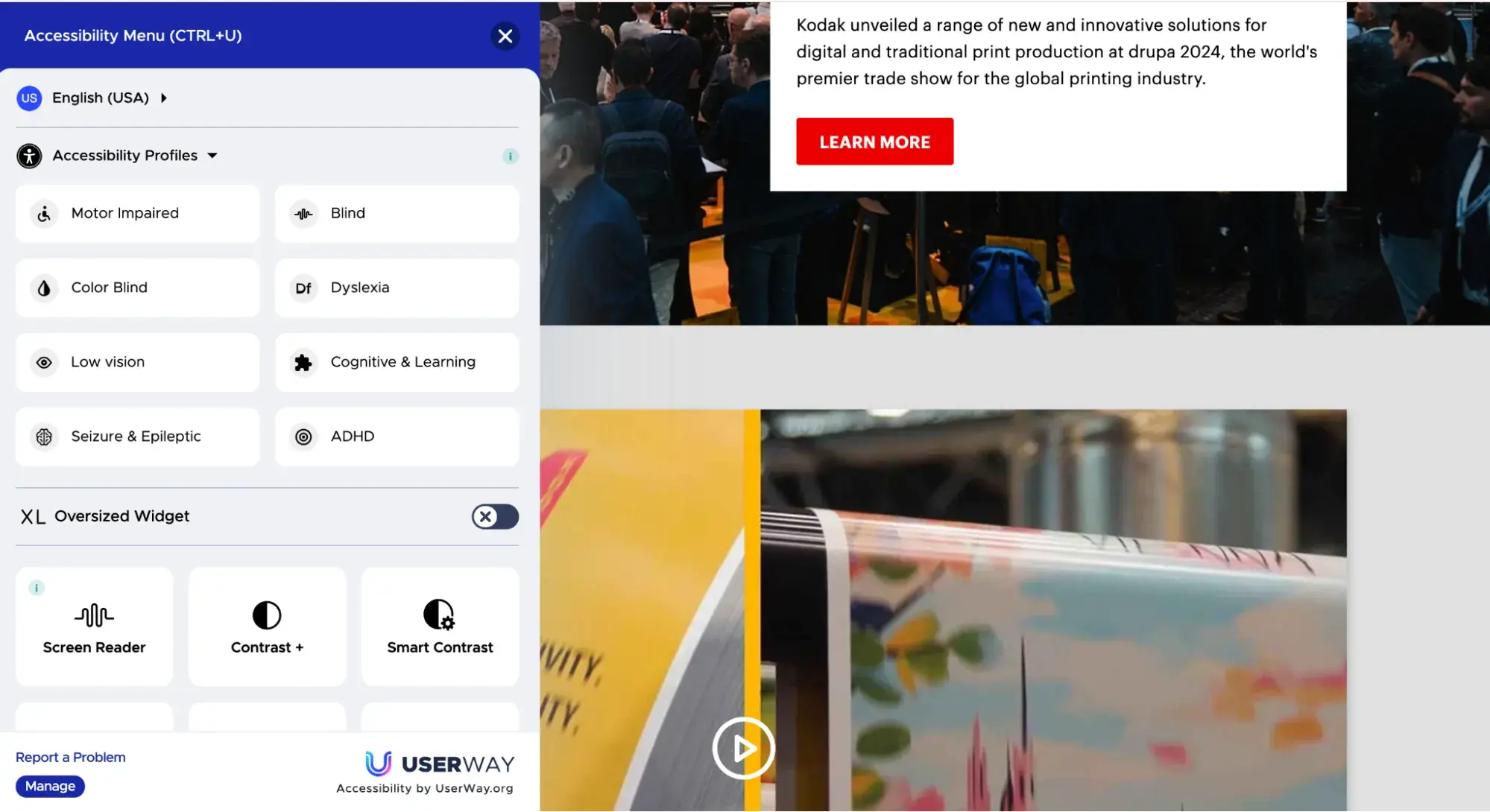
Further down on the widget, you can customize these settings a bit more. Options include legible fonts, contrast settings, removing images, cursor size, tooltip display, and more.
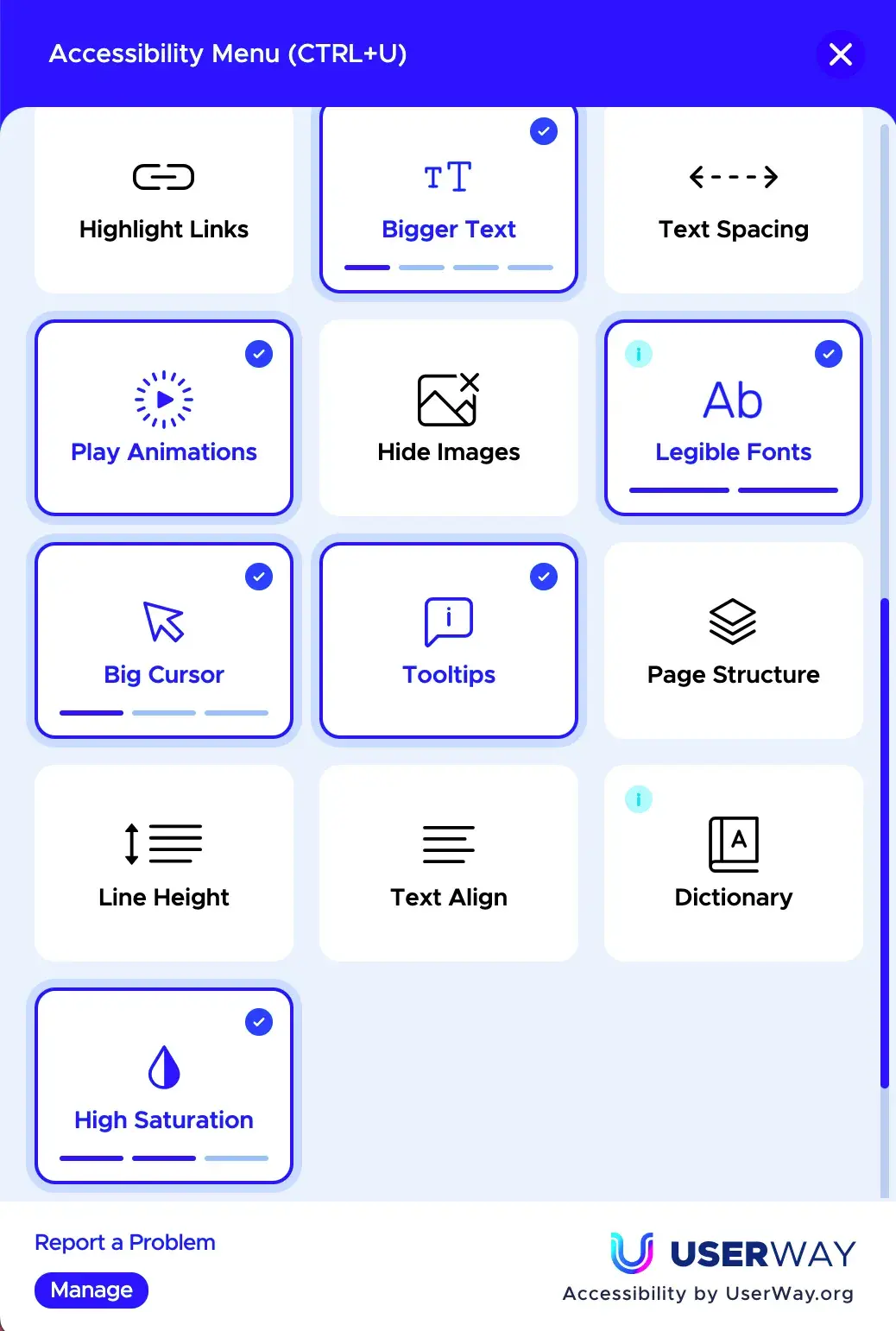
Pricing: UserWay pricing is separated out into the accessibility widget, accessibility monitoring, audits and VPATs, and more. The AI widget starts at $49 per month for a basic package, but monitoring and auditing features are priced annually, starting at $990 and $4,900 respectively.
What I Like: UserWay seems like one of the most in-depth tools from a functionality perspective, with the AI automating much of the accessibility work your website may need. The widget is very user-friendly too, and online reviews seem to validate the depth and speed of the monitoring tool as well.
6. Allyable
Allyable provides an accessibility website widget like some of the other tools above. However, it also uses AI to continuously scan your website and resolve accessibility issues to keep your site compliant. Allyable focuses on integrating closely with your development processes and aims to help you validate code for accessibility compliance before deployment, too.
Plus, it provides an AI tool for automatically generating captions for videos, podcasts, and live events in over 30 languages.
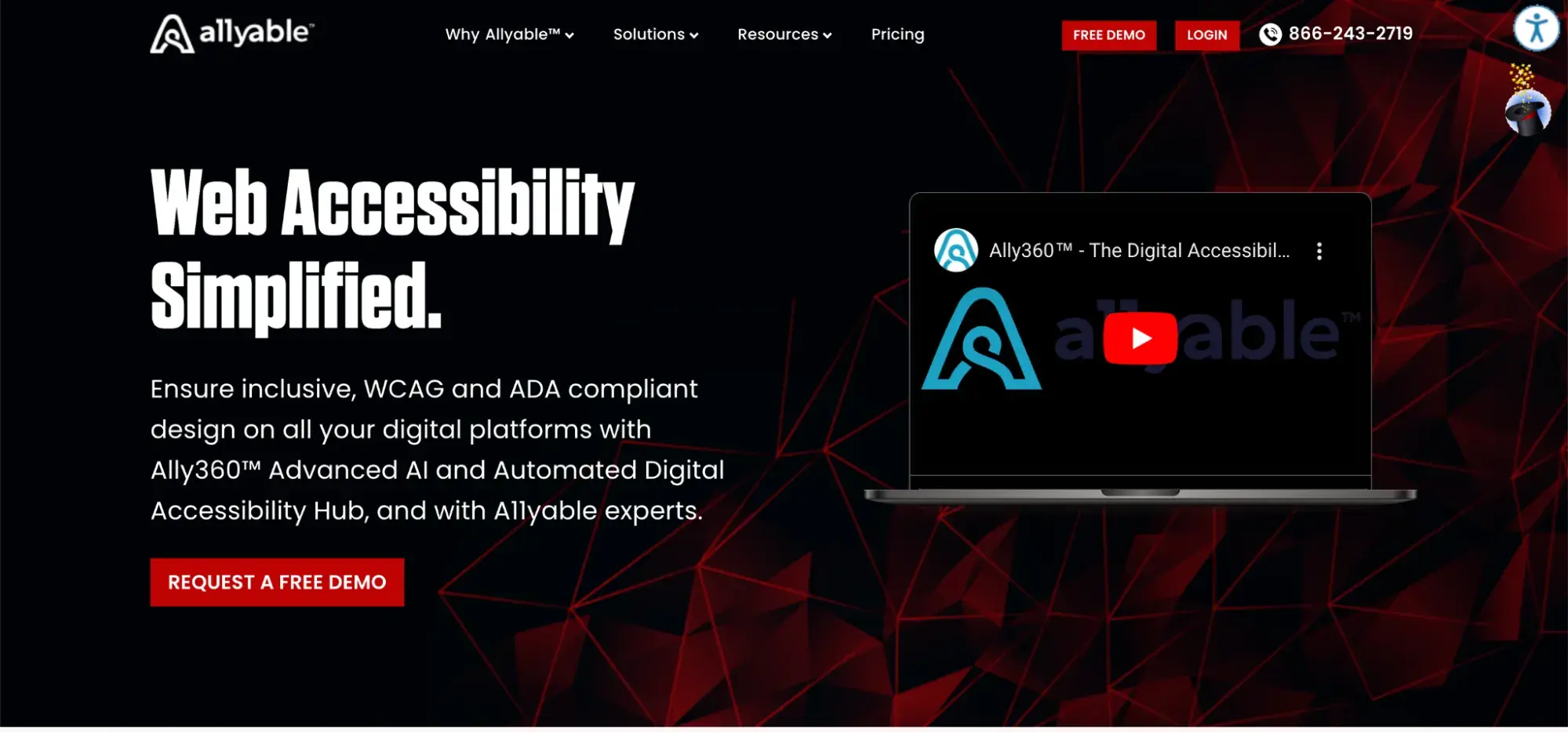
Unfortunately, there is no free trial available for Allyable for me to try it out myself. But they do provide a free demo booking option.
Pricing: Allyable pricing tiers are based on page views. They start at $49 per month for less than 100 page views, with tiering up to $489 per month for less than 100,000 page views.
What I Like: If you were generating thousands of pages across multiple websites or working on software apps, I think Allyable’s focus on integrating accessibility testing and checking into the development stage would be extremely useful and save a lot of time and resources on accessibility checks after deployment.
AI is Making Website Accessibility Easier and Faster
One of the most exciting features I came across when exploring web accessibility AI tools was the ability to pre-emptively cater to accessibility needs. But, for website developers and managers, the power of dynamic content updates and a much faster and more comprehensive accessibility audit will undoubtedly save hundreds of hours on manual testing.
The end result is a better website for users with accessibility needs — and more peace of mind for businesses and website owners when it comes to compliance.
Web Accessibility

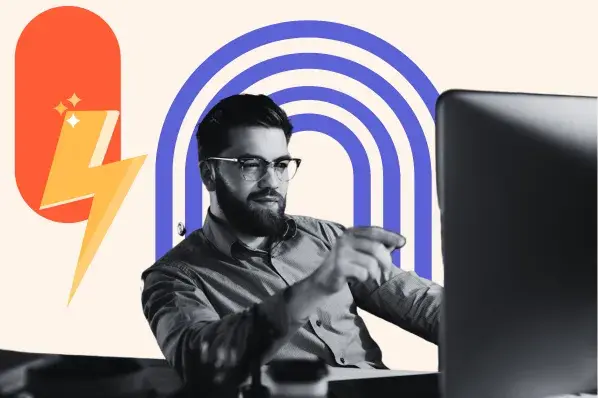
.png)

